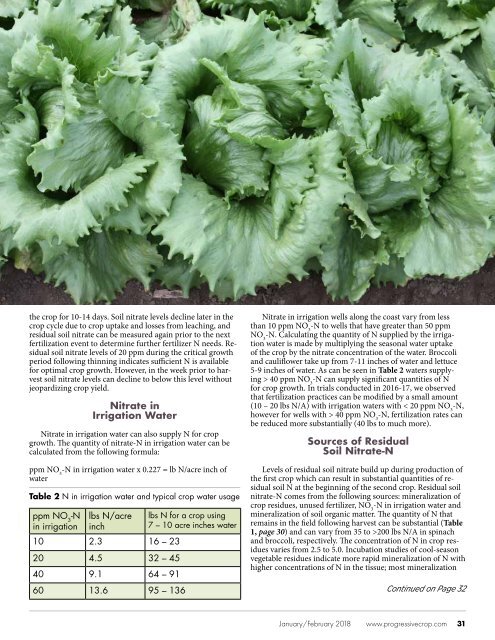Create successful ePaper yourself
Turn your PDF publications into a flip-book with our unique Google optimized e-Paper software.
the crop for 10-14 days. Soil nitrate levels decline later in the<br />
crop cycle due to crop uptake and losses from leaching, and<br />
residual soil nitrate can be measured again prior to the next<br />
fertilization event to determine further fertilizer N needs. Residual<br />
soil nitrate levels of 20 ppm during the critical growth<br />
period following thinning indicates sufficient N is available<br />
for optimal crop growth. However, in the week prior to harvest<br />
soil nitrate levels can decline to below this level without<br />
jeopardizing crop yield.<br />
Nitrate in<br />
Irrigation Water<br />
Nitrate in irrigation water can also supply N for crop<br />
growth. The quantity of nitrate-N in irrigation water can be<br />
calculated from the following formula:<br />
ppm NO 3<br />
-N in irrigation water x 0.227 = lb N/acre inch of<br />
water<br />
Table 2 N in irrigation water and typical crop water usage<br />
ppm NO 3<br />
-N<br />
in irrigation<br />
lbs N/acre<br />
inch<br />
10 2.3 16 – 23<br />
20 4.5 32 – 45<br />
40 9.1 64 – 91<br />
60 13.6 95 – 136<br />
lbs N for a crop using<br />
7 – 10 acre inches water<br />
Nitrate in irrigation wells along the coast vary from less<br />
than 10 ppm NO 3<br />
-N to wells that have greater than 50 ppm<br />
NO 3<br />
-N. Calculating the quantity of N supplied by the irrigation<br />
water is made by multiplying the seasonal water uptake<br />
of the crop by the nitrate concentration of the water. Broccoli<br />
and cauliflower take up from 7-11 inches of water and lettuce<br />
5-9 inches of water. As can be seen in Table 2 waters supplying<br />
> 40 ppm NO 3<br />
-N can supply significant quantities of N<br />
for crop growth. In trials conducted in 2016-17, we observed<br />
that fertilization practices can be modified by a small amount<br />
(10 – 20 lbs N/A) with irrigation waters with < 20 ppm NO 3<br />
-N,<br />
however for wells with > 40 ppm NO 3<br />
-N, fertilization rates can<br />
be reduced more substantially (40 lbs to much more).<br />
Sources of Residual<br />
Soil Nitrate-N<br />
Levels of residual soil nitrate build up during production of<br />
the first crop which can result in substantial quantities of residual<br />
soil N at the beginning of the second crop. Residual soil<br />
nitrate-N comes from the following sources: mineralization of<br />
crop residues, unused fertilizer, NO 3<br />
-N in irrigation water and<br />
mineralization of soil organic matter. The quantity of N that<br />
remains in the field following harvest can be substantial (Table<br />
1, page 30) and can vary from 35 to >200 lbs N/A in spinach<br />
and broccoli, respectively. The concentration of N in crop residues<br />
varies from 2.5 to 5.0. Incubation studies of cool-season<br />
vegetable residues indicate more rapid mineralization of N with<br />
higher concentrations of N in the tissue; most mineralization<br />
Continued on Page 32<br />
<strong>January</strong>/<strong>February</strong> <strong>2018</strong><br />
www.progressivecrop.com<br />
31


















